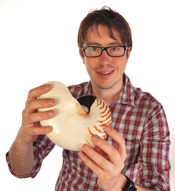Jon Ablett
Inspired by the stories behind the specimens, our mollusc curator looks after all the forms they take, from perwinkles to colossal squids.

Early aspirations
Jon didn’t realise scientists worked behind the scenes at the Natural History Museum until he took a degree in zoology, and studied here as a curatorial assistant during his sandwich year. He helped out in the fish section and undertook a research project in the herpetology section on caecilians, a weird group of amphibians that superficially look like snakes or worms.
By the end of his year, he knew he wanted to work at the Museum, and later interviewed to work with either with the worm or mollusc collections. He chose molluscs, and is now very glad he did, marvelling at their wide diversity across different environments, and that there are still new species continually being discovered.
Super specimens
Jon enjoys the stories behind the collections, such as a desert snail, Eremina desertorum, displayed in the Museum in 1846 that was found actually to still be alive four years later. It had entered a hibernation-like state, but when exposed to water, emerged from its shell and lived for another two years. It's is now back in the collections as a confirmed deceased specimen.
He also enjoys being a part of the history of the Museum and the specimens, adding knowledge to curiosities collected by people such as Charles Darwin and Joseph Banks, and making them available to scientists across the world.
Preserving life
Jon was at the start of one specimen's history at the Museum: the giant squid, affectionately named Archie. The more than eight metre long squid was caught off the Falkland Islands in 2004, and Jon led the effort to preserve Archie and prepare her for display.
With Archie in her tank is a portion of a colossal squid, a species which is believed to grow even bigger than giant squid. The main part of the body is missing, however, and a complete adult colossal squid would be Jon’s dream find. Despite their huge size, thought to be up to 18 metres long, little is known about how they live, eat and reproduce.